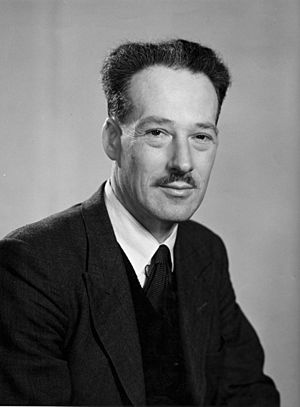Harry Fensom facts for kids
Quick facts for kids
Harry William Fensom
|
|
|---|---|

Fensom around the time he worked at Bletchley Park
|
|
| Born | 4 February 1921 |
| Died | 1 November 2010 (aged 89) Felixstowe, United Kingdom
|
| Occupation | Electronic Engineer |
| Known for | Worked on Colossus at Bletchley Park |
Harry William Fensom (born February 4, 1921 – died November 1, 2010) was a brilliant English electronic engineer. He played a key role in developing some of the world's first electronic computers.
During World War II, Harry Fensom worked at Bletchley Park. This secret location was where British codebreakers worked to crack enemy messages. He helped build the Colossus computer, which was the world's first electronic computer. Colossus was vital for decoding secret German messages.
After the war, Harry Fensom continued his important work. He designed a machine called ERNIE. This machine was based on the same ideas as Colossus. ERNIE is still used today to pick the winning numbers for Premium Bond prizes.
Early Life and Learning
Harry Fensom was born in Catford, a part of South London. His family moved to Fife in Scotland for a few years before returning to England.
He went to the Royal Liberty School where he was very good at maths and science. At 16, he decided to start working instead of going to university right away. He began his career as an engineer with the General Post Office (GPO). While working, he also studied at night school. He took special courses at different polytechnics to become an even better engineer.
World War II and Codebreaking
In 1942, Harry Fensom joined a special team at the Dollis Hill Research Station. He worked with famous engineers like Tommy Flowers. Their job was to create machines that could break secret codes.
He helped develop early electronic devices for codebreaking. These machines were designed to crack codes from the German Enigma machine. His work often took him to Bletchley Park, the top-secret codebreaking centre.
In December 1943, the first Colossus computer was set up at Bletchley Park. This amazing machine was built to decode messages from the German Lorenz cipher machine. The Lorenz cipher was used by the German High Command for their most secret communications.
A newer, faster version, the Mark II Colossus, was ready by June 1, 1944. This was just in time for the D-day landings on June 6. By the end of the war, ten Colossus computers were working non-stop. They helped the Allies understand what the German army was planning.
For example, the decoded messages revealed that Adolf Hitler believed the D-Day landings would happen at Calais, not Normandy. This secret knowledge gave the Allies a huge advantage. Historians believe that breaking these codes shortened the war by at least two years. It also saved hundreds of thousands of lives.
After the War
After World War II ended, Harry Fensom kept working for the GPO. In 1957, he was put in charge of designing a new machine. This machine was called ERNIE, which stands for Electronic Random Number Indicator Equipment. ERNIE's job was to randomly pick the winning numbers for the Premium Bonds.
Later, after he retired, Harry Fensom helped with a very special project. He assisted Tony Sale in rebuilding a working Colossus computer. This rebuild happened at the National Museum of Computing. Harry Fensom even visited another engineer, Allen Coombs, who had secretly kept his wartime notes. These notes were incredibly helpful for recreating the Colossus machine.

